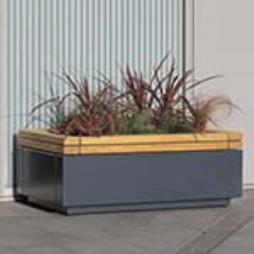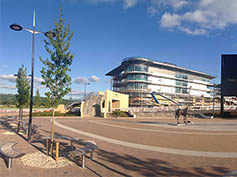Using planters to introduce greenery to public spaces - benefits
07-09-2016
Planters, tubs, pots and troughs bring easy care planting to areas with no soil, particularly streets, public spaces, even rooftops and areas where space is a premium and planting is otherwise impossible. With no major groundwork required when introducing planters to our streets, they can be placed quickly and easily, enhancing the quality and aesthetics of UK streets and public spaces.
Planters provide a defined area for planting, allow for easy maintenance, and provide reasons for the public to slow down, stop and reconnect with the world around them.
Improving public spaces with colour and greenery
Planters improve the look of our streets by adding colour and landscaping to areas which may otherwise represent an urban jungle to local inhabitants and visitors. Flowers, plants, trees and other greenery provide a welcome contrast to hard city streets, creating a positive, oasis like environment, softening the urban landscape. This makes areas more inviting and aesthetically pleasing, which in turn encourages people to spend time in these places.
Increased greenery in cities has a positive impact on public health, through the reduction of smoke, dust, CO2 and other pollutants. Plants and trees help to regulate air quality and climate, counter the warming effects of paved surfaces and reduce noise pollution levels. A range of studies have even shown how green spaces are linked to improved mental health, reduced stress, and can aid cognitive development in children.
When these pleasant areas are created, it’s important to make them welcoming, and to provide somewhere to sit. Introducing planters with integrated seats and benches is a simple way to ensure that the public enjoy spending time in these outdoor spaces, and can help to make people stay for longer – which in turn keeps towns and cities thriving and vibrant.
Uses in defining spaces and affecting movement
As well as providing a simple way of introducing greenery, large or small raised planters and other street furniture can also be used to define and demarcate spaces in the public realm. When used strategically, spaces can be divided, zones can be segregated, and pathways can be clearly separated from other areas. They can also be used to hide unsightly areas, to act as subtle visual and physical access barriers, or simply to enhance dead space between commercial buildings and roads.
The best streetscenes use planters and other street furniture intelligently, to affect flow and to direct pedestrian movement.
A range of planter designs and styles
The precise physical location of a street planter is normally the determining factor of its style and design. In most cases, as modern public spaces become more visually interesting, high quality, contemporary products are required. Rustic and industrial planter designs also have a place in certain schemes.
The use of shapes and heights adds variety and architectural value, with round, square and rectangular planters all available. Taller products, urns and bowls provide further choice.
Planters come in a variety of styles and a range of materials including steel, combined steel and timber, concrete, and more.






